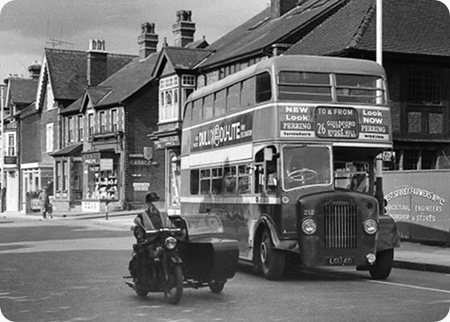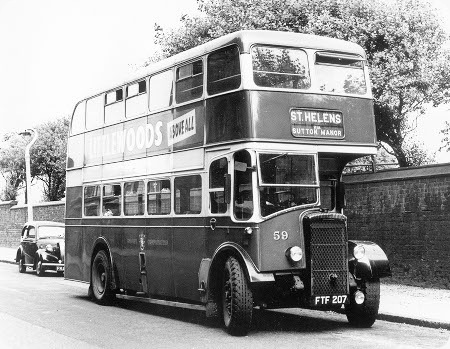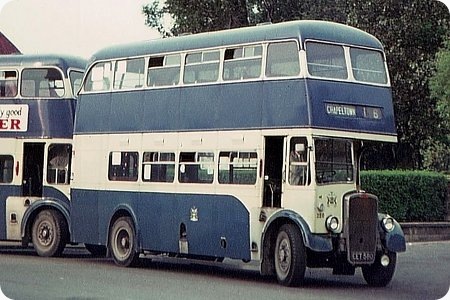Aldershot and District – Dennis Lance K4 – LOU 40 – 212
Aldershot and District Traction Company
1953
Dennis Lance K4
East Lancs L28/28R
This picture was taken in Woodbridge Road, Guildford, about 1961, and shows one of the 32 "tin fronted" Dennis Lance K4 buses unique to the Aldershot and District Traction Company. The first 20 of these had East Lancs L28/28 bodywork of the type shown, and the final 12 were bodied by Weymann with a version of the Orion, again seating 56 with 28 on each deck. The Gardner 5LW engines in these buses were removed from withdrawn Lancets of 1940 vintage, but were rebuilt and updated to the latest specification to virtually new standard. As usual with A&D buses, these vehicles had five speed gearboxes. I never drove one of these, but I understand that, with their slow revving (1700 rpm) 94 bhp engines they were less than lively, and not popular with the Aldershot and District driving staff, who christened them "Lulus" from their registration letters. The motorcycle and sidecar combination overtaking the bus is entirely characteristic of those times and something that is never seen today. I cannot identify the make of motorbike, but it is certainly something of a veteran itself as it has girder type front forks.
Photograph and Copy contributed by Roger Cox
———
26/06/11 – 11:32
The same nickname was given by Samuel Ledgard staff to ex London RT LLU 803 – her thunder was somewhat stolen though by the later arrival of some RTLs with the same "Christian name."
Despite the cumbersome and leisurely progress of the A & D Dennis Lance I have to say that it is an extremely attractive vehicle indeed – the characterful destination display and the beautiful livery of that operator being the icing on the cake.
Chris Youhill
———
26/06/11 – 19:59
Aldershot and District always had a small engine policy, and it is difficult to understand why the Lance K4 should have been singled out by certain staff for a modest performance. The pre war Lances with the high set radiator style (as on the Lancet II and III) were delivered with Dennis four cylinder sixteen valve O4 engines of 6.5 litres giving 82 bhp. Most of these early Lances were later rebodied and refitted with 5LW engines, and the wartime Guy Arabs also had the 5LW powerplant. The first postwar ‘deckers were Lance K3s with the Dennis O6 of 100 bhp, and these were lively, smooth running buses, and the following K4s of the type shown above must have seemed much more sedate by comparison. Then came Lolines powered by the 6LW engine, and it is probable that, by a certain point in time and within the experience of some drivers, the Lance K4s were the only double deck buses in the fleet still using the 5LW. My experience of the K4 as a passenger indicated that its road performance was fully up to the general standard of the time.
Roger Cox
———
27/06/11 – 11:48
Happily, Tim Stubbs and Malcolm Spalding rescued sister ship A&D K4 220 some years ago, and it has been a regular at running days and other events for at least seventeen years. I’ve had the very good fortune to be on the driving rota, and it really a most characterful bus, with the reassuring thump of the 5LW and the unique 5-spd gearbox, with 1st, 2nd and 3rd sliding (not constant)mesh and preselective overdrive. The cab is not a model of comfort or convenience, but the steering is a joy. Brakes are vacuum over hydraulic, and seem to need frequent adjustment but are wonderfully progressive in action.
Seating is 28 on each deck. On top, counting from the front, the seats are for 4, 4, 3, 4, 3, 4, 3 and 3. Even on a 27-long body eight rows upstairs was still less common than seven on mid-fifties lowbridge bodies but—as on contemporary Roe lowbridge products—the back seat upstairs is set as far back as it can be without compromising staircase headroom, so there’s plenty of knee room between seats.
She’s admittedly slow in hilly country, but will do 48mph on the flat and on a well-chosen route puts the miles behind her surprising quickly.
Tim’s K3 of 1950, with the Dennis O6 engine, is 6" narrower and a foot shorter but is actually slightly heavier than the K4. Unlike the 5LW, the amazingly smooth O6 is a spinner, not a slogger. The difference in engine gives the two otherwise very similar vehicles a totally different character. The 5LW demands a well-adjusted clutch-stop, but the lighter flywheel of the O6 makes it unnecessary for upward changes—except 1st to 2nd on hills.
These two vehicles are wonderful survivals, and it’s a pity that none of the lightweight (and apparently very lively) Weymann Orion-bodied K4s survived. When I first saw one at Reading Station the pop-rivets put me off. How could my schoolboy judgment have been so flawed!
There should be Dennis delights at Alton Running Day, Hampshire, this July the 17th, and the big event is 100 years of Aldershot&District at Farnborough, Hants, Sunday May the 27th 2012.
Ian Thompson
———
28/06/11 – 06:24
Ian, I lived in Farnborough, Hants, for nine years from the mid sixties, by which time the Loline reigned supreme in the A&D double deck fleet, and I had a spell at Aldershot depot as a driver before returning to the admin side of the bus industry at Reigate. Although I have travelled as a passenger on the A&D K3 and K4 Lances, and my knowledge of Dennis buses goes right back to 1946 to 1949 when, as a child, I used to travel with my mother on the pre war O4 engined East Kent Lancet IIs between Faversham and Herne Bay, I have never driven a Lance or a Lancet. I have always had a strong regard for traditional Dennis machines, and Dennis were the only British manufacturer to put oil engines with four valves per cylinder into quantity production. Crossley made a wartime prototype "four valver" that performed well, but when Saurer asked for a royalty or licence fee for the use of its combustion chamber design, Crossley hastily redesigned the engine as a "two valver" with catastrophic consequences for reliability and performance. I am envious your driving sessions in these old Dennis buses, and it is wonderful to see them in preservation. My own short lived foray into the preservation scene was as part of a group that saved the Dennis Ace YD 9533. The costs of restoration became prohibitive, and we sold it on, and it is now thankfully a regular on the rally scene. The Ace was certainly an interesting machine to drive with its central accelerator pedal! I now live in East Anglia, but I will certainly bear in mind next year’s Aldershot and District centenary
Roger Cox
———
28/06/11 – 11:38
Roger, I’m equally envious of your youthful rides on 04-engined Lancets. From what I’ve heard, they were livelier than one might expect from only 6.5 litres. I believe one is preserved and I very much hope one day to have a ride on it. I used to think the days of four-cylinder engines powering full-size buses were behind us, but the new Alexander-Dennis diesel-electrics in Reading, Oxford and Manchester seem to manage very nicely with their little fours.
When I worked at Smiths in Reading there were still 04 engine bits in the workshop, although the last 04s were probably off the road by 1960.
The only Ace I’ve ever ridden on in genuine service took me from Yarmouth to Freshwater, Isle of Wight, but the sound was all wrong as it had a Bedford OB engine and gearbox.
I can see why Crossley had for legal reasons to hurriedly redesign the Saurer combustion chamber, but I wonder why at the same time they abandoned the 4-valve head? That surely wouldn’t have infringed any patents.
The Reading downdraught-engined Crossley deckers were certainly slow, with their UW of 8.3.1, and they tended, oddly, to be used on the hillier routes, but they lasted for 18 years, so the workshop must have got a feel for keeping them happy.
Ian Thompson
———
29/06/11 – 06:52
Ian, your comments on Dennis and Crossley machines has prompted me to add a few more. My memories as a four to seven year old might now be optimistically tinged with nostalgia, but I do recall the curious muffled drumming sound of the Dennis O4 engines, very different from the local Maidstone and District Tigers (petrol and diesel), but the progress was very smooth and lively. I loved those old Dennis Lancets, and the high mounted radiator offset to the nearside denoted a truly independently minded manufacturer. The later Lancet III was surely one of the finest vehicles of its time.
I have some b/w pictures of three Smiths of Reading Lancets that brought a private party to Hampton Court in 1961. I will send them to the site in due course.
Still with Reading, I have a few pictures of that operator’s all Crossley DD42/8 machines which, as you say, were fitted with the downdraught engine that represented AEC’s attempt to mitigate the abysmal characteristics of the HOE7. I took the pictures in 1967 by which time the Dennis Loline reigned supreme in the double deck fleet. Having moved to the Gosport area when I was nine years old, I frequently saw the Portsmouth Crossleys in service, but I never travelled on a bus of this make until 1958, by which time I was living in the Croydon area. This was the year of the seven week London bus strike, and an outfit grandiosely calling itself "The People’s League for the Defence of Freedom" obtained permission to run some routes during the stoppage. One of these was route 2 between Croydon and New Addington, and two of the four buses allocated were ex Lancaster Corporation all Crossley SD42 (the others were an ex Crosville TD7 and an ex Lytham St Annes CWA6). Admittedly the Crossleys were 11 years old by then, and always well loaded, but I was amazed by the truly mediocre hill climbing performance of these machines. I have a picture of HTC 614 at New Addington taken with my trusty Brownie 127, and will send it in sometime.
Roger Cox
———
29/06/11 – 06:58
The strange thing about the Crossley HOE engine was that they never cured, or bothered to cure, the breathing problems that became apparent with the conversion to two-valves per cylinder. Yet, when AEC took them over, the problem was sorted out quite quickly!
Chris Hebbron
———
29/06/11 – 19:41
Chris, judging by the comprehensive "Crossley" book by Eyre, Heaps and Townsin, the Crossley Motors company did not take kindly to external criticism, and any that was forthcoming merely served to strengthen the firm’s intransigence, a very curious attitude to adopt in a fiercely commercial environment. Thus, not only did it take no meaningful action to solve the shortcomings of the HOE7, but it appeared to resent the AEC solution that appeared as the downdraught engine, even continuing to supply unmodified HOE7 engines in new buses. A similar cussedness was displayed in respect of the steering geometry on all Crossley buses. A simple readjustment in design would have cured the exceptionally heavy steering characteristics, that, in the case of the three axled "Dominion" trolleybuses, bordered on the impossible, but Crossley would not shift its position. No wonder AEC got fed up.
Roger Cox
———
30/06/11 – 05:33
What amazes me about Crossley is the difference in attitude between their chassis and body departments. Whereas the chassis people stuck stubbornly to their own ideas come what may, their first standard postwar body was designed not by Crossley but by Manchester Corporation. The special Manchester features – curves, waistrail steps and cantilever platform – quickly became optional, and even the first Liverpool bodies were actually the de-Manchestered Manc design reworked as a four-bay body with a flat front, as required by the Liverpool spec. I don’t think Crossley ever designed a double-deck body from scratch at all, although their postwar framing system was all their own.
Peter Williamson
———
01/07/11 – 05:27
Thank you Roger and Peter, for mentioning the diverse attitude of the two parts of Crossley, one self-serving and the other accommodating towards its customers. As we know, a chain is only as good as its weakest link!
Chris Hebbron
———
03/07/11 – 19:54
Talking about Track routes to this day the Arriva service 268 Dewsbury- Bradford service is still referred as the Track although in tramway days the service only went as far as Moorend as did service G in bus days.The service 281 Bradford to Thornhill is always referred as The Donkey for obvious reasons.
Philip Carlton
———
30/04/12 – 07:53
Roger, in his copy, records that these vehicles had five-speed gearboxes, but I seem to recall that they had four-speed boxes with overdrive. The driver would move the lever in a semi-circular way to gain overdrive. I only travelled on them from Woking to St. Peter’s Hospital, Ottershaw, a very flat route, so was never able to judge their hill-climbing capabilities. When living in Portsmouth, I did travel on the Petersfield – Guildford route as far as Milford on a couple of occasions, but that was on a Loline. I imagine that the Lances would also have been on that challenging route over the North Downs and I’d have loved to have ridden on them up there!
A childhood delight was going on holiday, around 1950, from Kingston – Southsea on a duplicate Southdown Leyland Cub coach. But I digress!
Chris Hebbron
———
30/04/12 – 09:12
Oh, there you go – as Chris Youhill has said elsewhere, that’s the fun of this site. Digress away. After the pathetic failure that was yesterday’s Cobham/Wisley event, we may only be left with our digressions!
David Oldfield
———
01/05/12 – 06:48
Well, the weather must have been appalling, if Gloucester was anything to go by, but were there other problems, too, David?
Chris Hebbron
———
01/05/12 – 06:50
Chris, the Dennis gearbox was an overdrive unit, giving five gears in all. Overdrive was a preselective gear designed using Maybach principles. To engage from fourth, the gear lever was moved at any time, as with a conventional preselector, to the left and forward, and actual engagement occurred when the accelerator was released to allow the revs to die. When the accelerator was pressed again, fifth gear was already engaged. To change down, the lever was moved back to the fourth position, and engagement occurred when the accelerator was released and then pressed again to raise the revs for the fourth ratio. Sadly, I have never driven a Dennis with such a gearbox, though I have travelled many miles as a passenger on Lances and Lancets so equipped. Ian T is the expert when it comes to practical experience.
Roger Cox
———
01/05/12 – 06:51
Is that Arthur and Olive from On the Buses just passing?
Philip Carlton
———
01/05/12 – 19:27
We were discussing this on Sunday, Chris, saying that the organisers might use the weather as an excuse. The weather was atrocious – but that wasn’t the problem. Most of the "runs" were a circuit of the airfield – not a decent run on proper roads. The 499 to/from Weybridge Station was supposed to be half modern low-floor vehicles – it was even worse. More of them, supplemented by re-engined RMs. I have friends "high" in the industry who said after Dunsfold, and then this, they will no longer be supporting it. Likewise people in the business who are enthusiasts who brought their own vehicles from wide and far. We were charged £10 to enter, get soaked and find nothing to entertain us – and a further £2 for the programme. Sorry you got me going Chris, but it wasn’t the weather and, despite living up the hill, it won’t be in my diary next year.
Rant over, now let’s get on with friendly sharing of expertise and experience.
David Oldfield
Quick links to the - Comments Page - Contact Page - Home Page



